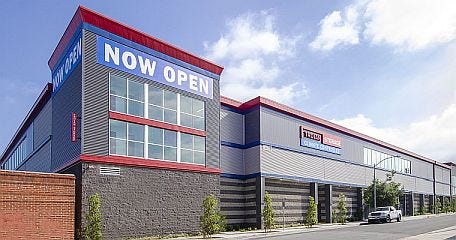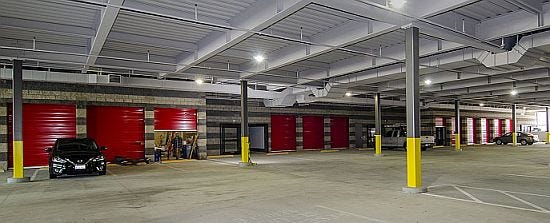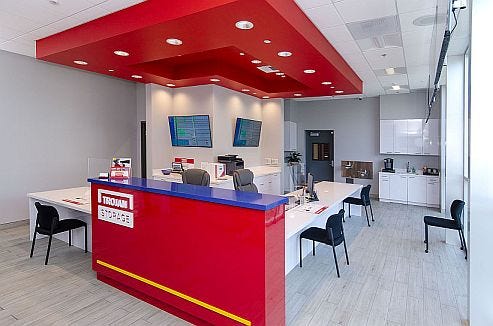A Complicated Journey: Building Trojan Storage in Glendale, CA
Self-storage developers have faced a slew of hurdles in recent years including lagging approval times, labor shortages and cost increases. The process of building Trojan Storage in Glendale, California, was similarly challenging. Read about the facility design, construction obstacles and workarounds, and more.

Trojan Storage in Glendale, California, a Los Angeles suburb, is a thriving, well-designed facility. However, the journey toward completion was not without difficulties.
The building almost entirely occupies the 1.8-acre site, boasting more than 200,000 gross square feet. With industrial zoning, the development team was able to take advantage of zero-foot setbacks, thus giving the project a massive presence in a heavily developed area. The property has excellent frontage along the Colorado Street exit of Interstate 5 and visibility from the highly traveled San Fernando Road, making it unparalleled in terms of exposure. It’s also near a Home Depot and across the street from a newly constructed Amazon warehouse.

Riding in the on the coattails of the COVID-19 lockdown, the project had to contend with numerous government shutdowns and limited staffing. Even when the world began to wake up from hibernation, city planning departments were backlogged. Couple that with rising material costs and labor shortages, and the Trojan facility was off to a rough start.
The development team was also forced to deal with a litany of power-line issues, as the site was once home to a multi-tenant shopping center. This was worked through with dry-utility consultants and legal counsel; but ultimately, they were forced to relocate the lines out into the street.
Further complicating matters was the exorbitant amount of parking required for self-storage in this area. Fortunately, the team was able to secure a parking-reduction permit by providing data specific to the industry. This critical step allowed the owner to maximize square footage instead of wasting valuable land on parking spaces that would never be occupied.

Site Constraints
The urban location and high cost of land certainly influenced Trojan’s design and layout. The goal for the project was to maximize the leasable area, but with such a small footprint, the only logical solution was to go vertical.
The city had very specific lighting, glazing and landscape requirements, but there were also unique opportunities, such as the ability to install faux self-storage units facing San Fernando Road. A sprinkler curtain wall was created since the neighboring building is immediately adjacent; however, with the building height reaching 46 feet, the display is still highly visible. It’s complemented by a large bank of faux doors and signage that face north to capture the attention of freeway motorists and nearby retail clientele.
Still, the size of the facility forced the design team to implement a three-hour area separation wall, effectively turning the project into two separate buildings to be code-compliant. To keep the flow of the interior loaded space, a fire-door system with magnetic hold-opens was specified. In addition, due to the limited area for site drainage, the civil engineer designed a completely internal system via two costly, modular wetland systems.
First-Floor Features
To centralize customer loading/unloading and reduce travel distances to individual units, the design team created a first-floor drive-through with large overhead doors that remain open during business hours. It has significant camera surveillance. This solution required a substantial mechanical system powered by rooftop HVAC units to provide ventilation.
Also on the first floor, within the building envelope, are four elevators and an above-ground, fire-rated vault required by the utility company. The office is simple but makes a significant statement in Trojan’s bold red branding. The contemporary feel conveys cleanliness and security, with bright colors and lighting to accent the high-end casework and flooring. While limited in size at just under 900 square feet, this space maintains functionality with monitors depicting the views of the numerous onsite security cameras.
The higher first-floor elevation permitted the installation of small, limited-height “lockers” above the ground-floor units to take advantage of otherwise wasted space. Accessed via a rolling ladder, these were a creative way to add density to the project without being penalized on the floor-area-ratio calculation.
The first-floor exterior is comprised of alternating colors of concrete block on the majority of the façade, with a single-color block to emphasize the architectural towers. The city insisted on some articulation at the street level, so the design team elected to recess the concrete block and provide metal-clad pilasters. Within these reveals are small pockets of landscaping showcased by downcast lighting from the cantilevered floor above. The upper floors are adorned with a combination of corrugated metal panel, flat metal panel and glazing with faux units beyond.

Construction Challenges
Because the primary structure occupied nearly the entire site, with no vacant lots in the direct vicinity, the builder had very limited staging area. They cleared this hurdle by first constructing the exterior walls and working toward the interior. While required, this approach resulted in complex coordination with the subcontractors.
The construction team also had to deal with palpable disconnects between the building and planning departments when it came to final inspections. Items that had previously been approved by the planning department had to be changed in the field to appease the building department. Material and design changes were addressed on the fly as the team readied the facility for opening.

The Glendale facility stands as Trojan’s largest new build to date, with 165,000 net rentable square feet. The project experienced a variety of delays and issues, but it’s been leasing up at an accelerated rate, with 50% filled in just eight months. It’ll no doubt be a success for decades to come.
David Meinecke is vice president of Jordan Architects, a design firm that specializes in self-storage, custom residential, hospitality, land planning, multi-family and retail. He has more than 14 years of experience in self-storage design and development. A member of the national Self Storage Association’s Young Leadership Group, he holds a bachelor’s degree from the University of San Diego and is an associate member of the American Institute of Architects. For more information, call 949.388.8090 or email [email protected].
About the Author(s)
You May Also Like





